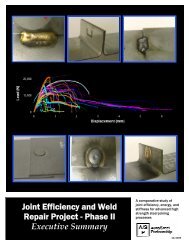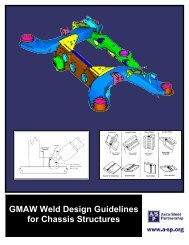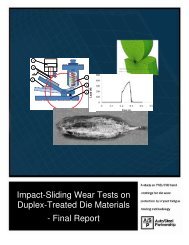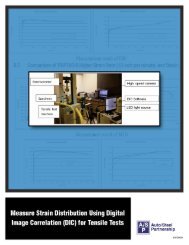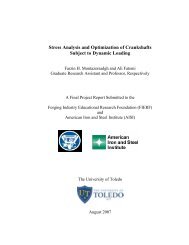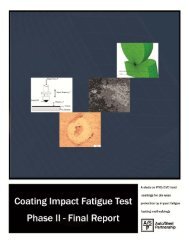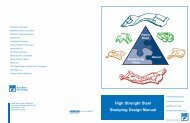Light Truck Frame Joint Stiffness Study Phase 1 Final Report
Light Truck Frame Joint Stiffness Study Phase 1 Final Report
Light Truck Frame Joint Stiffness Study Phase 1 Final Report
You also want an ePaper? Increase the reach of your titles
YUMPU automatically turns print PDFs into web optimized ePapers that Google loves.
APPENDIX A: ABSTRACTS<br />
36. Dynamic Response of Hollow Section <strong>Frame</strong>s with Bolted Moment Connections<br />
Mourad, S.; Ghobarah, A;. and Korol, R.M.<br />
Engineering Structures, 1995<br />
The behavior of moment-resisting steel frames under various types of loads is dependent on the type<br />
of beam-to-column connections and their flexibilities. The extended end-plate connection is a<br />
practical field bolted moment connection that can be adopted in moment-resisting steel frames with<br />
hollow structural steel (HSS) columns, by using high strength blind bolts. The objective of this work<br />
was to study the behavior of blind bolted extended end-plate connections for HSS columns under<br />
cyclic loading. With proper detailing and modeling of such connections, it has been possible to<br />
investigate the effect of joint flexibility on the response of the frame when subjected to dynamic<br />
loading and then to compare its response to that of a rigid frame. It is concluded that the proposed<br />
bolted joint behaves in a predictable manner that can be modeled and analyzed using standard frame<br />
analysis programs. The study also showed that the inclusion of the connection flexibility in frame<br />
analysis is essential to obtain a more realistic frame behavior.<br />
37. Towards an Exact Value for the Flexural <strong>Stiffness</strong> of Tall Rigid <strong>Frame</strong>s<br />
Olowokere, D.; Aktan H.; and Akanni, A.N.<br />
Computers & Structures, 1991<br />
The contribution of the flexural stiffness of tall rigid frames to the overall lateral stiffness of the<br />
building is evaluated. The parametric study is conducted for nine different rigid frame geometries<br />
representing shear wall-frame buildings commonly employed. Each frame of appropriate grid<br />
geometry and pre-sized cross-sections is subjected to prescribed lateral loading. The lateral<br />
deflection of the various column joints is computed using the stiffness method. Subsequently,<br />
retaining the same moment of inertia, the cross-sectional areas of all columns are increased to<br />
simulate an axially infinitely stiff column and each frame is re-analyzed using the same lateral loading.<br />
The difference in the computed horizontal joint deflection from each of the analyses represents the<br />
lateral displacement of the frame due to axial strains in the columns and, hence, a measure of the<br />
'flexural' deformation of the frame.<br />
38. Stress Concentration Factors for Non-90° X-Connections Made of Square Hollow Sections<br />
Packer, J.A. and Wardenier, J.<br />
Canadian Journal of Civil Engineering v 25 n 2 Apr 1998<br />
A number of fatigue experiments and stress concentration factor measurements on non-90°, square<br />
hollow section X-connections have been carried out. Comparison of the measured stress<br />
concentration factors with those derived from existing parametric formulae for 90° T- and X-<br />
connections showed a strong influence of the brace angle. A tentative extension of the range of<br />
validity of the parametric formulae for 90° T- and X-connections for other brace angles has been<br />
derived. English (Author abstract) 15 Refs.<br />
39. Automotive Body <strong>Joint</strong> Analysis for Improved Vehicle Response<br />
Rao, Zebrowski, and Crabb<br />
A comprehensive analysis system for defining the flexible characteristics of body structural joints is<br />
described. A static test methodology of obtaining joint stiffness characteristics is presented. A joint<br />
databank, consisting of linear joint stiffness characteristics, is developed. A mini-computer based<br />
dynamic joint stiffness testing methodology for obtaining dynamic joint stiffness characteristics, which<br />
can be integrated into finite element body models, is explained. Finite element joint modeling<br />
procedures for obtaining joint stiffness characteristics, before hardware availability, are outlined. A<br />
<strong>Report</strong>: A/SP-005-1 <strong>Light</strong> <strong>Truck</strong> <strong>Frame</strong> <strong>Joint</strong> <strong>Study</strong> 80



